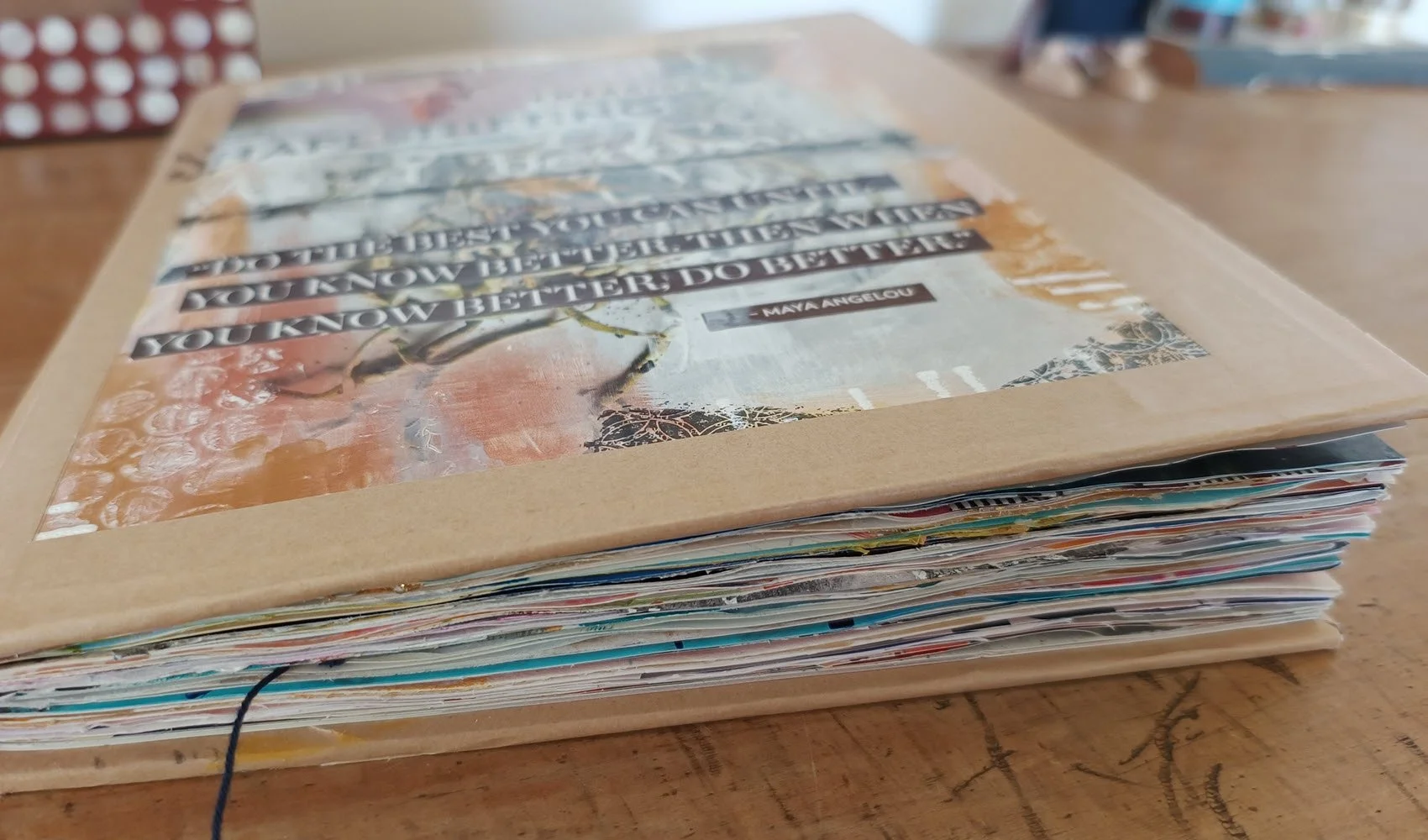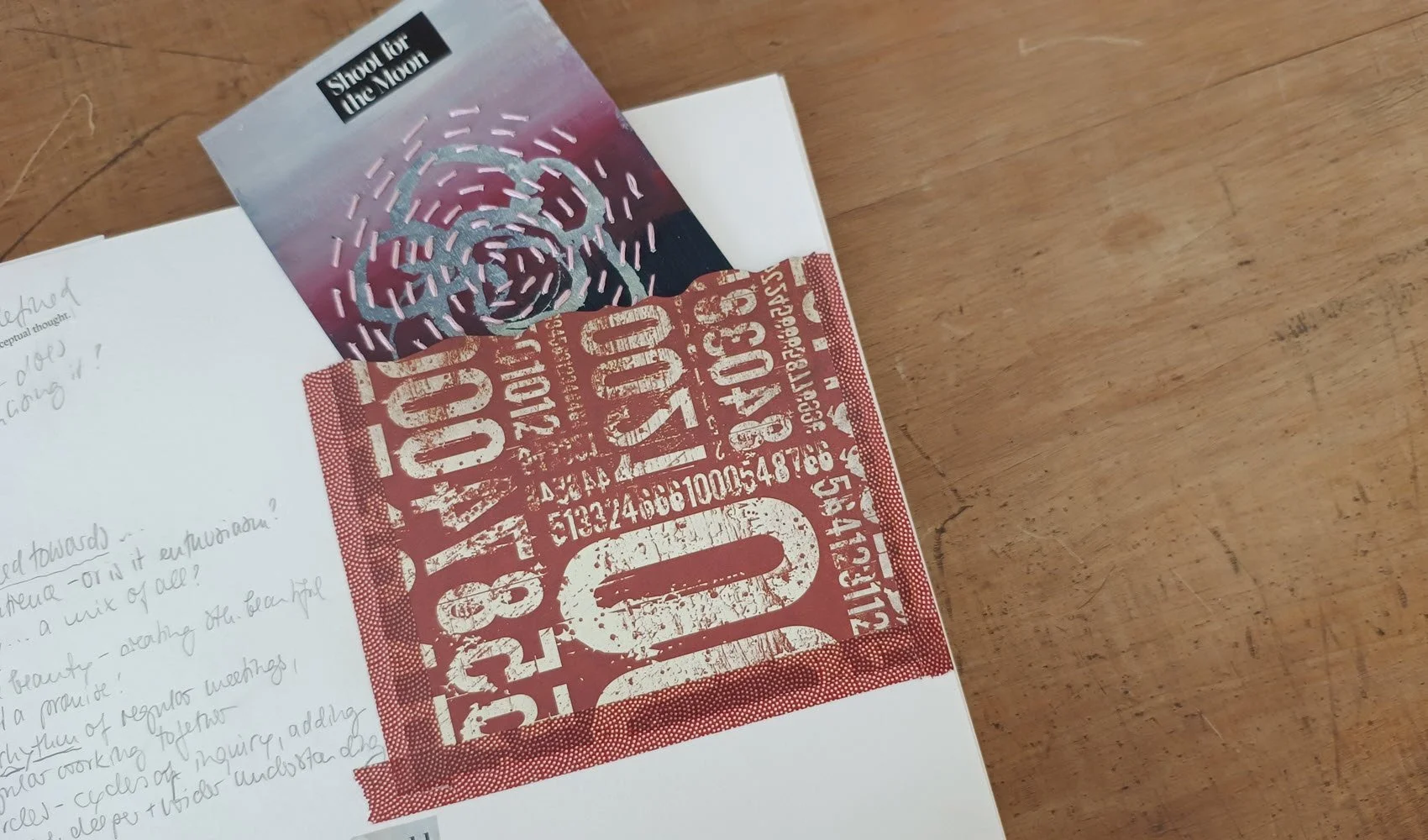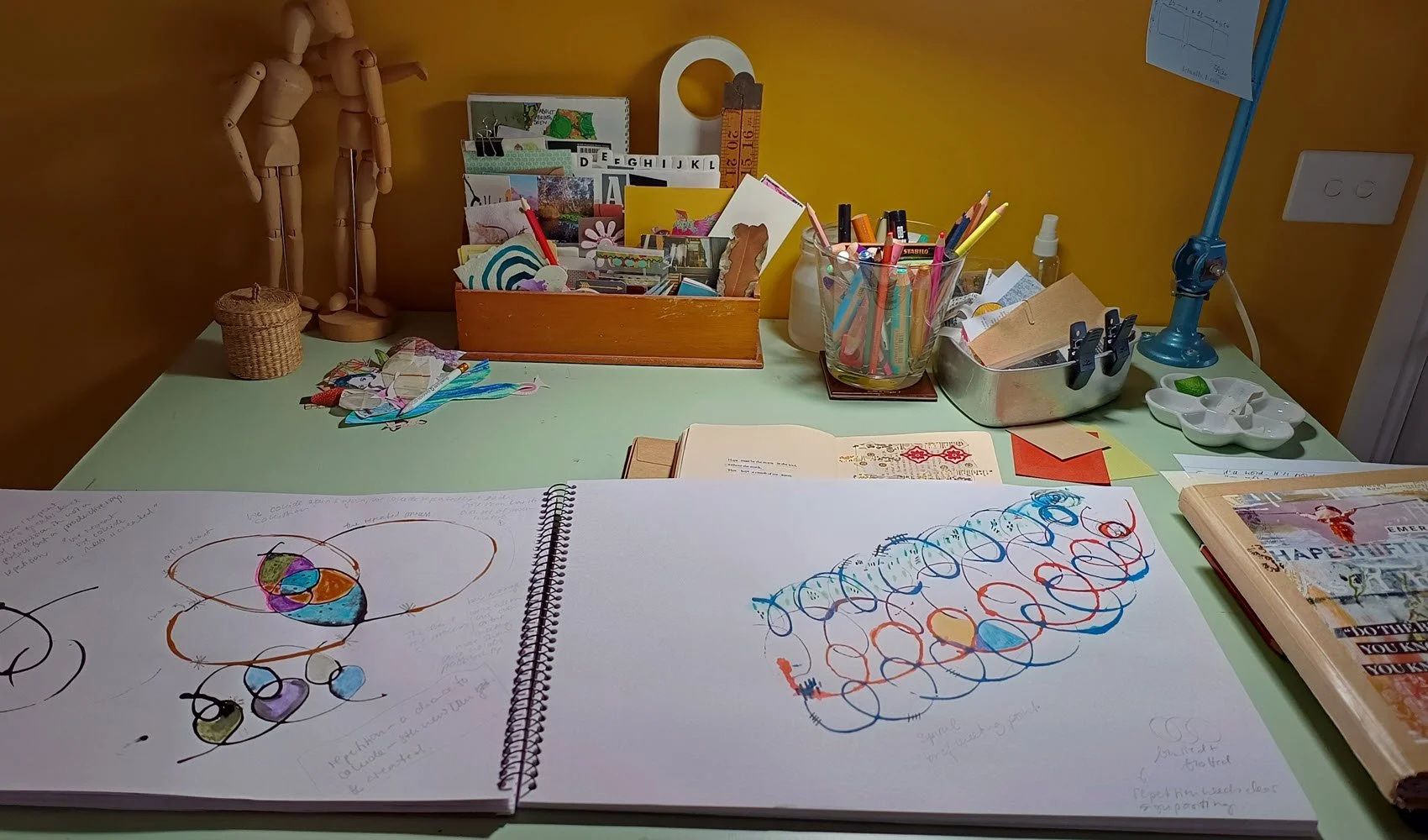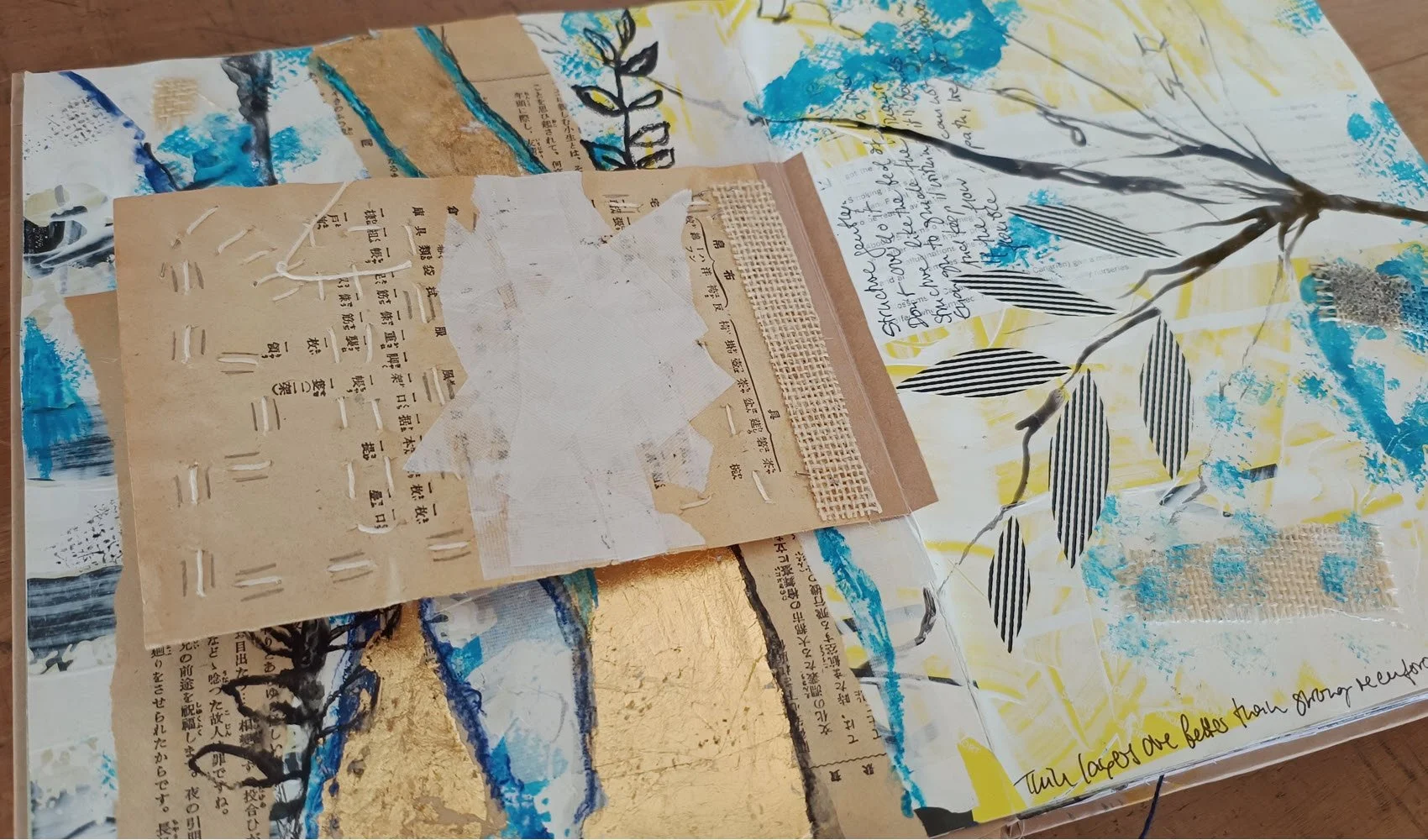Keeping a reflective journal: the studio book
In the past two years, I’ve worked with quite a few people in small online groups with the focus on building and cultivating a reflective practice.
A desire that comes up a lot is to develop a practice that captures our arts-based processes in art journals or sketchbooks.
Personally, I love working with books as they provide a great container and structure for my reflective practice.
Journals organise insights and reveal patterns.
Usually, patterns become visible over time. Having your reflections in one place helps with that pattern recognition. We notice how certain words, memories, themes, questions, colours, marks or motifs turn up again and again. If we keep notes and reflective artwork in separate journals or on separate sheets of paper, it’s easy to lose track of these salient themes and miss patterns as they emerge.
Journals highlight progress.
Having everything in a book or journal makes it much easier to revisit reflections to make our progress and evolution visible for ourselves. Being able to go back in time shows us how we have worked for our progress. Shifts in our inner world or outer lives haven’t just happened magically or through dumb luck. We can trace our reflective footsteps to the initial insights and the actions we took on the back of them. Sometimes, our journals remind us of setbacks or stuckness and how we responded, this helps build resilience and strengthens self-belief.
I’ve noticed how much it matters how I talk about these journals or books.
How I refer to them affects how people approach the practice: whether they feel encouraged, curious and open or intimidated, hesitant and cautious.
Therefore, I wanted to reflect on a few different types of journals or books and how I’ve seen these work with people in the early stages of practice building.
If you wonder where to start with keeping a reflective journal the following thoughts and ideas on different types of books and how to use them might help.
Notebooks:
Notebooks are wonderful for a journaling practice. They are useful to document, jot down ideas, as a commonplace book or bullet journal. If I use the term notebook or even journal, people often restrict themselves to writing as their main reflective process. But my intention is to get people curious about other forms of expression beyond words and the books we use in reflective practice typically hold more than notes.
Arts-based reflective practice involves writing, and also drawing, painting, mixed media, creating found poems, collage, stitching… which means the paper has to be up for taking a bit of glue, water, ink, or paint without disintegrating.
Verdict: a notebook or journal might not be up to being your main book for arts-based reflections, but it can be an excellent companion for another type of book that is holding your arts-based explorations and creative reflections.
My notebook - great for notes and to support my reflective process, but less suitable for arts-based reflections using all sort of materials and processes.
Sketchbooks and Art Journals:
Sketchbooks are usually made of high-quality drawing or watercolour paper which is great for the different processes and materials we’re using in arts-based reflection.
For many, however, the term sketchbook seems to belong firmly to ‘real’ artists and their creative practice. Many people I work with don’t see themselves as artists.; it can be hard enough to believe in their inherent creativity!
Art journaling often uses sketchbooks and when people talk about art journals, they imagine each page as a framing-worthy artwork, finished and complete. In the conventional sense, an artwork is typically the result of a longer creative process; if we approach a representation we made in a much shorter timeframe in our reflective practice with the same expectations, we set ourselves up for feeling disheartened. For many, perfectionism stretches its tentacles: unless each page is ‘good’ they want to abandon their sketchbook/ art journal altogether.
The beautiful, heavy, expensive paper of sketchbooks/ art journals can become a barrier: it’s too good to be used. It’d be wasteful to use it for some mark making and other experiments that support our reflective process but might not end up being an ‘artwork’.
Verdict: the paper quality of sketchbooks is great, but makes them an expensive option. Both terms can be too aspirational during the early stages of practice building. They sometimes awaken stories of lacking skills or talent. We don’t feel enticed or encouraged, but hesitant and unsure.
A page from an old art journal which I don’t use in my current reflective practice as these sort of journals focused on artmaking and didn’t lead me into reflection.
Altered books:
I love creating altered books; turning an old cookbook or coffee table book into a reflective journal is super satisfying!
The term ‘altered book’ is also a nice mirroring of the process we’re engaging in: turning an unused book into a deeply personal journal and giving it a new purpose, mirrors the change that often happens in us (and in our outside lives) as we cultivate a reflective practice.
Altering an existing book typically requires you to get the pages ready for arts-based processes: this could mean priming them with gesso or covering them with paper so that you can draw and paint on it. At the start of building a practice, this can be too complicated, too much faff, and therefore, it’s just an unnecessary barrier.
Verdict: they are a cheap option and if you can see the requirement to prime pages as an enjoyable part of your preparation, a ‘warm-up for your hands’, altered books can be beautiful, hugely satisfying and they always feel very special.
One of the altered books I’m currently working in. It’s an old chemistry book and I love how the spine cracks open with each page I alter.
My (current) favourite term - Project Books or Studio Books:
When supporting people in building their own reflective practice the terms project book or studio book have emerged as my favourites.
When I speak about project or studio books, I can convey that these books are the container for the process, where the work happens; they’re not meant to be an art gallery in book form. This removes pressure and keeps perfectionism under control.
I recommend a paper quality of 120gsm - for me that’s the sweet spot of good enough quality to withstand the different materials without getting too expensive or ‘too good to use’.
A page in one of my current studio books - you can see the process notes on the right…
Verdict: project book or studio book capture the notion that these books are the container for our reflective experiments without the expectation that each page is a work of art or leads to something we find aesthetically pleasing. You can of course turn a quality sketchbook into a studio book if the high price and beautiful paper quality don’t make you think about it as too precious to get stuck in.
After years of experimenting, I’ve currently landed in a happy place that involves three different types of books to hold my reflective practice.
My studio books
They are the container for my everyday reflective practice; in this context, everyday doesn’t mean that I do it daily, it refers to it being my run-of-the-mill practice. Each page shows that that my reflective practice is a process of sensemaking: a capturing of thoughts, words, feelings, colours, shapes, imagery, followed by some dot-connecting. Maybe I should simply call them sensemaking journals!?
The pages are a far cry from being a piece of art and that’s the intention. There are annotations, process notes and crossed out words. You find failed experiments and successful ones. Some processes seem complete, others still open-ended. On occasion, when I haven’t directly worked in the studio book, bits of paper get stapled to a page or tucked into a pocket I created.
I add reflective art made outside my studio book to the book by creating pockets or stapling it to a page.
This helps me keep all my reflections in one place. When I reflect on recurring themes, I can make connections quickly and easily because it’s all there. It’s obvious in these books that I don’t take huge amounts of time for an arts-based process. I use these processes to access parts of my brain that hold implicit knowing and speak in colour, shape or images.
At the moment, I’m using an A3 visual journal with 120gsm paper from a standard office supplies store. They are fairly inexpensive (just under $7), so I have no hesitation to experiment or cut holes into pages. I use them with inks and paints, I draw and collage in them, and I don’t mind if the paper warps a little or some ink or markers bleed through the paper. These books are my workhorses, not created for display – even though I find them insanely satisfying to flick through!
While A3 can make your studio book a bit big and heavy (and it would certainly not travel well!), I love the larger format right now. It provides enough space for meandering processes and inquiries that might consist of a few separate representations. And there’s plenty of room to annotate, capture important insights or anything that comes up in me in response to my reflective art.
My altered books
I tend to keep my altered books to a certain topic or area of life. I have one that documents my evolution from pure art therapy into arts-based coaching. I have another one that holds my arts-based meaning practice and focuses on using the Map of Meaning.
The pages I create in my altered books are often more layered and use mixed media; I might work on them for longer or dip in and out of the process over a few days. I’ve used old cookbooks and a chemistry book found in an op shop; any book that has thicker pages which don’t disintegrate at the sight of some water, glue or paint will work well.
My tiny practice
I do keep a small A5 sketchbook for my tiny practice and dedicate it entirely to one reflective process with the intention to do it daily. The tiny practice gets launched periodically and on demand; it’s not a practice I’m always engaged in. I tend to feel drawn to this type of practice when there’s lots going on in life that needs digesting.
Usually these are times when I (and it may be the same for you) need to take care of how I manage my energy. When big life events take up a lot of processing power it’s easy for my regular practice to fall by the wayside. But at the same time, I could really benefit from some reflecting and sensemaking.
The tiny practice helps me maintain my connection to my reflective practice without weighing me down. It’s not just tiny in size, it also comes with minimal complexity. I simply keep doing the same thing each day (or on most days) until I no longer need this scaffolding. As I’ve already lots going on, I don’t need to make any decisions other than showing up. I had times when I did a tiny daily collage and some writing. Other times it was a found poem and some writing. I pick whatever feels possible and interests me at the time.
What sets you up for a sustainable practice is to be clear about your intention, your capacity and some practicalities:
Why do you want a practice in the first place? What are you hoping to get out of it and how/ when can you see yourself engaging in reflection?
What’s your capacity, in terms of time and energy levels?
What practical considerations are important? How much time do you have? What’s the space like which you would be using? Do you travel a lot? What materials do you enjoy working with?
It’s much easier to start small and expand your practice than starting ambitiously and having to reinvigorate a practice after having ‘fallen off the wagon’.
Also allow curiosity to guide you. The best type of book or journal is the one you want to open and work in.
If you want to explore arts-based coaching in a 1-on-1 setting, book a free Discovery Call or find out more here.
If you’re curious about my reflective practice group programs get in touch or look at current programs.








